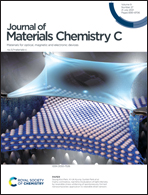Enabling efficient ambipolar charge carrier mobility in a H-bonded heptazine–triphenylene system forming segregated donor–acceptor columnar assemblies†
Abstract
Hydrogen (H)-bonded C3 symmetrical discotic liquid crystals (DLCs) (Hpz-Cn-TP, n = 6, 8, 9) forming segregated columnar assembly are described. The columnar architectures are formed by electronically decoupled donor (D) (triphenylene) and acceptor (A) (heptazine) units linked through complementary H-bonding. Unlike triazine, tris(triazolyl)triazine and tris-benzimidazolyl benzene which have been explored in depth to form H-bonded DLCs, a new heptazine core has been explored, herein, for the first time to develop functional supramolecular materials of technological importance. Among Hpz-Cn-TP complexes, both Hpz-C8-TP and Hpz-C9-TP showed ambipolar charge transport with the former demonstrating a maximum hole mobility of 1.60 cm2 V−1 s−1 and the latter showing a maximum electron mobility of 2.90 × 10−3 cm2 V−1 s−1, measured through the space-charge limited current technique. Not only discrete conduction channels but also highly preorganized homeotropically aligned conduction pathways are observed in the reported complexes, resulting in efficient ambipolar charge transport. The adopted H-bonded synthetic approach does not only contribute to the electronic decoupling of D and A units but also offer an easy synthetic route to achieve DLC materials with high purity that have widespread use in commercial organic electronics.



 Please wait while we load your content...
Please wait while we load your content...